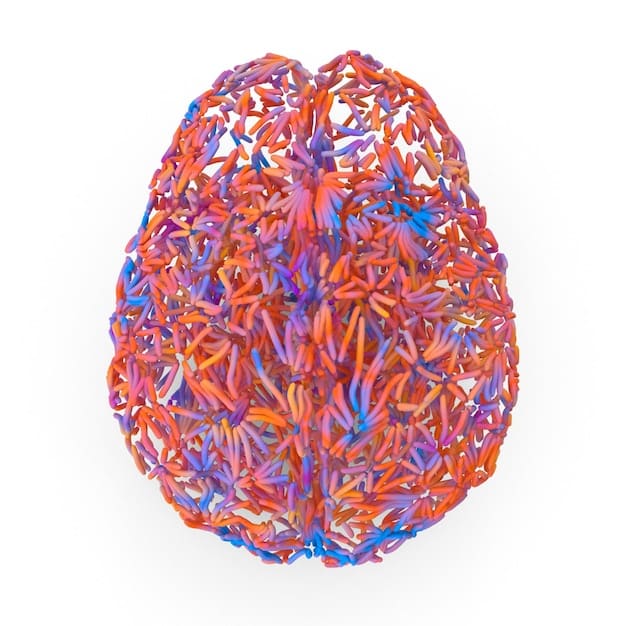Circadian Rhythms in 2025: Boosting Productivity with Science

Latest research on circadian rhythms suggests optimizing work schedules and environments to align with natural sleep-wake cycles, which can significantly enhance productivity in 2025 by improving focus, energy levels, and overall well-being.
The relentless pursuit of productivity often overlooks a fundamental aspect of human biology: our internal clock. **How Does the Latest Research on Circadian Rhythms Impact Productivity in 2025?** Understanding and leveraging these rhythms could be the key to unlocking greater efficiency and well-being in the workplace.
Understanding Circadian Rhythms: A Primer
Circadian rhythms are more than just sleep-wake cycles; they are intricate biological processes that regulate various bodily functions over a roughly 24-hour period. These rhythms influence hormone release, body temperature, and even cognitive performance. Understanding these rhythms is crucial for anyone seeking to optimize their productivity.
Disruptions to these rhythms, often caused by factors like shift work, jet lag, or excessive screen time, can lead to a host of negative consequences, including decreased cognitive function, mood disturbances, and increased risk of chronic diseases. By aligning our daily activities with our natural circadian rhythms, we can potentially mitigate these risks and enhance our overall well-being.
The Science Behind Our Internal Clock
The suprachiasmatic nucleus (SCN), located in the hypothalamus, acts as the master clock that coordinates circadian rhythms throughout the body. The SCN receives light input from the eyes, using this information to synchronize the body’s internal clock with the external environment.
Recent research has delved deeper into the molecular mechanisms underlying circadian rhythms, identifying specific genes and proteins that play a crucial role in regulating these rhythms. This research has opened new avenues for developing interventions aimed at optimizing circadian alignment and improving various aspects of health and performance.
- Genetic Factors: Certain genes influence an individual’s chronotype, determining whether they are naturally inclined to be morning larks or night owls.
- Environmental Cues: Light exposure, meal timing, and social interactions serve as powerful cues that can influence the timing and stability of circadian rhythms.
- Hormonal Regulation: Hormones like melatonin and cortisol are released according to circadian rhythms, playing a key role in regulating sleep, stress response, and energy levels.
In summary, understanding the fundamentals of circadian rhythms is the first step towards harnessing their power to boost productivity and improve overall health. Recognizing the intricate interplay of genetic, environmental, and hormonal factors allows us to make informed decisions about our daily routines.

The Productivity Impact: Latest Findings
The connection between circadian rhythms and productivity is becoming increasingly clear through emerging research. Studies consistently demonstrate that aligning work schedules with an individual’s chronotype and natural sleep-wake cycles can lead to significant improvements in focus, alertness, and overall cognitive performance.
One key finding is the variability in peak performance times among individuals. For example, morning larks tend to be most productive in the early hours, while night owls may experience their peak productivity later in the day. Recognizing and accommodating these individual differences is essential for optimizing team productivity.
Chronotype and Performance
Research suggests that individuals who work during their preferred chronotype experience greater job satisfaction, reduced stress levels, and improved overall performance. Conversely, working against one’s natural circadian rhythm can lead to chronic sleep deprivation, decreased cognitive function, and an increased risk of errors.
Strategies such as flexible work hours, personalized scheduling, and the incorporation of rest breaks during low-energy periods can help to mitigate the negative effects of circadian misalignment and promote optimal performance.
- Improved Focus: Aligning work schedules with circadian rhythms enhances concentration and reduces distractions.
- Increased Alertness: Working during peak alertness times improves cognitive processing speed and decision-making ability.
- Enhanced Mood: Optimal circadian alignment promotes a positive mood and reduces the risk of burnout.
In conclusion, the latest research underscores the profound impact of circadian rhythms on productivity. By understanding and accommodating individual chronotypes and the natural fluctuations in energy levels throughout the day, organizations can foster a more productive and engaged workforce.
Strategies for Circadian Alignment in the Workplace
To fully realize the productivity benefits of circadian alignment, organizations can implement several practical strategies. These strategies range from simple adjustments to the physical work environment to more comprehensive changes in scheduling and management practices.
One of the most impactful strategies is optimizing light exposure. Exposure to bright, natural light during the day helps to reinforce the body’s natural circadian rhythm, while minimizing exposure to blue light from screens in the evening promotes better sleep quality.
Optimizing Light Exposure
Installing blue-light filters on computer screens, using dimmable lighting fixtures, and encouraging employees to take breaks outdoors can all contribute to a healthier and more productive work environment. Additionally, light therapy lamps can be used to simulate natural sunlight during the darker winter months.
Furthermore, adjustable workstations that allow employees to alternate between sitting and standing throughout the day can promote better circulation, reduce fatigue, and improve overall energy levels.
- Natural Light: Maximize access to natural sunlight in the workplace.
- Blue-Light Filters: Implement blue-light filters on all computer screens.
- Light Therapy Lamps: Consider using light therapy lamps during the winter months to combat seasonal affective disorder (SAD).
In summary, creating a work environment that supports circadian alignment requires a multifaceted approach. By prioritizing light exposure, flexible scheduling, and ergonomic design, organizations can empower their employees to work in harmony with their natural rhythms and unlock their full potential.

The Role of Technology in Monitoring and Enhancing Rhythms
Technology is playing an increasingly important role in both monitoring and enhancing circadian rhythms. Wearable devices such as fitness trackers and smartwatches can track sleep patterns, activity levels, and light exposure, providing valuable insights into an individual’s circadian rhythm.
This data can be used to personalize interventions aimed at improving sleep quality, optimizing work schedules, and promoting overall well-being. For example, an app could analyze an individual’s sleep data and suggest optimal times for going to bed and waking up, as well as recommend activities to improve sleep quality.
Wearable Devices and Personalized Insights
Furthermore, software applications can be used to create personalized work schedules that take into account an individual’s chronotype and peak performance times. These applications can also incorporate features such as reminders to take breaks, notifications to adjust lighting, and guided meditation exercises to reduce stress levels.
Looking ahead, advancements in sensor technology and artificial intelligence are likely to further enhance the ability to monitor and personalize circadian rhythm interventions. For instance, smart home devices could automatically adjust lighting and temperature based on an individual’s sleep patterns and activity levels.
- Sleep Tracking: Wearable devices can provide detailed insights into sleep patterns and sleep quality.
- Personalized Schedules: Software applications can create personalized work schedules that align with individual chronotypes.
- Smart Home Integration: Smart home devices can automate environmental adjustments based on circadian rhythms.
In conclusion, technology offers powerful tools for monitoring and enhancing circadian rhythms. By leveraging the data collected by wearable devices and the capabilities of artificial intelligence, individuals and organizations can gain a deeper understanding of their internal clocks and implement personalized interventions to optimize productivity and well-being.
Future Trends: Circadian Lighting and Personalized Workspaces
The integration of circadian lighting in the workplace is set to become more widespread in the coming years. Circadian lighting systems mimic the natural changes in light intensity and color temperature that occur throughout the day, providing a more stimulating and productive work environment.
These systems can be programmed to gradually increase light intensity in the morning to promote alertness and reduce blue light exposure in the evening to promote relaxation and sleep. Studies have shown that circadian lighting can improve mood, reduce fatigue, and enhance cognitive performance.
The Rise of Personalized Workspaces
Furthermore, the concept of personalized workspaces is gaining traction as organizations increasingly recognize the importance of accommodating individual preferences and needs. Personalized workspaces can include features such as adjustable lighting, temperature controls, ergonomic furniture, and noise-canceling headphones.
These customized environments can help to reduce distractions, improve comfort, and enhance overall productivity. As technology continues to evolve, we can expect to see even more sophisticated and personalized workspace solutions emerge.
- Circadian Lighting: Mimics natural light patterns to regulate circadian rhythms.
- Personalized Settings: Adjustable lighting, temperature, and ergonomics.
- Smart Technology: Integration of AI to optimize workspace conditions based on individual needs.
In summary, the future of workplace design is closely linked to our understanding of circadian rhythms and the importance of personalization. By incorporating circadian lighting systems and creating customized workspaces that cater to individual preferences, organizations can foster a more engaged, productive, and healthy workforce.
Overcoming Challenges: Shift Work and Jet Lag
While aligning work schedules with circadian rhythms offers numerous benefits, certain professions and lifestyles can pose significant challenges. Shift work, characterized by irregular and often unpredictable work hours, disrupts the natural circadian rhythm, leading to a host of negative health consequences.
Similarly, frequent travel across time zones can cause jet lag, which results in fatigue, insomnia, and decreased cognitive function. Addressing these challenges requires proactive strategies aimed at mitigating the negative effects of circadian misalignment.
Strategies for Shift Workers and Travelers
For shift workers, strategies such as strategic light exposure, timed melatonin supplementation, and consistent sleep-wake schedules on days off can help to stabilize circadian rhythms. Furthermore, organizations can implement policies that limit the number of consecutive night shifts and provide adequate rest breaks.
For travelers, strategies such as gradually adjusting sleep-wake schedules before departure, using light therapy to shift circadian rhythms, and staying hydrated during travel can help to minimize the effects of jet lag.
- Light Therapy: Use light boxes to simulate sunlight and adjust sleep cycles.
- Melatonin Supplements: Timed melatonin intake can help regulate sleep.
- Consistent Schedules: Maintain a regular sleep-wake pattern, even on days off.
In conclusion, while shift work and jet lag pose significant challenges to circadian alignment, proactive strategies can help to mitigate their negative effects. By prioritizing sleep hygiene, utilizing light therapy, and implementing evidence-based interventions, individuals and organizations can minimize the disruptions to their natural rhythms and maintain optimal health and performance.
| Key Point | Brief Description |
|---|---|
| ⏰ Circadian Alignment | Syncing work with your body’s natural rhythm improves focus and energy. |
| 💡 Light Exposure | Natural light boosts daytime alertness; reduce blue light at night. |
| ⌚ Wearable Tech | Track sleep and activity to personalize circadian interventions. |
| 🏢 Personalized Workspaces | Adjustable settings enhance comfort and reduce distractions. |
Frequently Asked Questions
▼
Circadian rhythms are the body’s natural, internal processes that regulate the sleep-wake cycle and repeat roughly every 24 hours. They influence various physiological functions, including hormone release and body temperature.
▼
Aligned circadian rhythms enhance focus, alertness, and cognitive performance, leading to increased productivity. Conversely, disruptions can impair cognitive function and reduce efficiency.
▼
Improve your circadian rhythm by maintaining a consistent sleep schedule, maximizing exposure to natural light during the day, reducing blue light exposure at night, and managing stress levels effectively.
▼
Latest research emphasizes the importance of personalized workspaces, circadian lighting, and flexible work schedules to support optimal circadian alignment and boost overall employee productivity and well-being.
▼
Technology, like wearable devices and smart home systems, helps monitor sleep patterns, personalize work schedules, and adjust environmental conditions to promote better circadian alignment and overall health.
Conclusion
As we move closer to 2025, the importance of understanding and harnessing circadian rhythms for productivity will only continue to grow. By implementing the strategies discussed and embracing the latest technological advancements, individuals and organizations can unlock significant gains in focus, energy, and well-being, ultimately leading to a more productive and thriving future.





